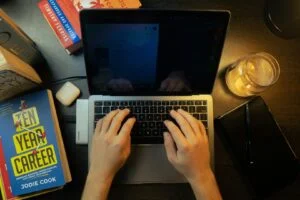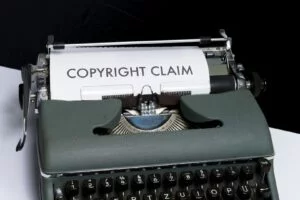In this post, we'll be looking at how to reference other people's work correctly, with advice and guidance from this week's guest blogger, experienced Editor and ALLi Partner member Amelia Winters.
From why citations matter, to avoiding copyright infringement, this post will give you the key information you need to apply referencing and citation techniques to your non-fiction books.
Introducing References and Citations for Non-Fiction Authors
Let’s be honest: writing citations is tedious at best and mind-numbing at worst. I can do it, and I can do it well, but it’s not the part of my editing job that fills me with the most excitement and joy. Why do we even bother with this stuff, anyway?
There are several reasons why we cite our sources:
- To provide external evidence to support our arguments.
- To be open and honest about where we are drawing our ideas from.
- To make it easy for our readers to find our sources so they can either double check our work or read more about the subject at hand.
In other words, we cite other people’s work to make sure our own work is clear, supported, verifiable, and honest. These principles are the bedrock of intellectual integrity. Now, intellectual integrity has a nemesis: it’s called plagiarism. Citations are the safety net that prevents us from falling into the trap of accidental plagiarism.
Plagiarism is when you take someone else’s intellectual creation, claim it as your own, and distribute it for your own gain. That gain can be financial, but it can also be more abstract gains, such as time or clout. A stressed student may steal someone else’s work just to save themself some time. Someone who wants to be viewed as intelligent may steal smart ideas from other people to improve their reputation.
The Moral Stuff: Why Citations Matter
 Just like the regular theft of material goods, intellectual theft hurts people. That’s why we generally consider theft morally wrong—it causes harm. That may seem like an obvious point, but because intellectual property is so abstract, it can be easy to lose sight of how plagiarism can tangibly hurt people.
Just like the regular theft of material goods, intellectual theft hurts people. That’s why we generally consider theft morally wrong—it causes harm. That may seem like an obvious point, but because intellectual property is so abstract, it can be easy to lose sight of how plagiarism can tangibly hurt people.
When you steal someone’s food, it leaves a physical void; the original owner loses their access to the food, which is a very direct, measurable harm. However, when you steal someone’s words, that person technically still has those words. A text is a non-physical thing that still gets to exist in the writer’s mind, books, and computers even after it has been stolen.
So, unlike material theft, intellectual theft does not immediately negate anything that the original owner has. Instead, it prevents the owner from gaining the full benefits of distributing their intellectual property as their own.
Even though those benefits are indirect, losing them can still be very material and impactful. Writers use their words to make money and care for themselves. By taking someone else’s words, you seriously damage their sources of income, and that is a very tangible harm.
It’s easy to say that stealing intellectual property is bad, but it can be hard to define what is and is not intellectual property, and what does and does not count as stealing it. That’s where detailed laws and citation practices come in to provide some kind of clarity and consensus.
So, yes, writing citations is a headache. Navigating copyright law is tedious and stressful. But it’s important to remember why we do these frustrating things: it helps us respect and protect each other’s intellectual integrity in ways that can socially and materially impact all of us.
So, let’s take a look at those guidelines and laws.
The Legal Stuff: How to Avoid Copyright Infringement
The first thing to know is that copyright laws vary according to different countries. So, the rules you need to follow will vary according to the country you’re publishing in.
If I tried to summarize one country’s copyright laws, it would inevitably be incomplete and limited. Also, I’m an editor, not a lawyer. Nothing I’m about to say should be considered legal advice. If you’re unsure about anything, your best bet would be to consult a lawyer. Still, I can point you to helpful resources.
Professional Publishing Resources on Copyright
Here are the professional style guides that provide publishing copyright guidelines for different countries. These are the sources publishers and editors use to navigate publishing laws. Since these books are written for professional editors, the language will be formal, dry, and meticulous. But critically, it will also be accessible. You won’t need to speak legalese to follow these texts, and they should be able to answer most of your copyright questions.
First, we have the publishing Bible of North America: The Chicago Manual of Style (CMOS), 17th edition. It has a whole chapter dedicated to US copyright law. You’ll find it in Chapter Four, “Rights, Permissions, and Copyright Administration” by William S. Strong. You can click here to access the online copy of the CMOS. You should also be able to find a physical copy in most major libraries and bookstores in North America.
Next, for writers publishing in the UK, know that New Hart’s Rules: The Oxford Style Guide is the UK equivalent of the CMOS. It too has a thorough chapter on UK copyright: “Chapter 20: Copyright and other publishing responsibilities.” That will be your go-to source for UK copyright guidelines.
For authors publishing outside the US and UK, you should be able to find equivalent publishing style guides that cover your country’s copyright laws. The CMOS and Hart’s Rules are pretty ubiquitous within English-language publishing. So, your country’s publishers may still use them as their go-to style guides. However, an authoritative style guide that covers your country’s specific copyright laws should exist somewhere.
For example, in my home country, Canada, most book publishers still use the CMOS. However, we also have The Canadian Press Stylebook (CPS). Even though the CPS is written primarily for journalists, it still covers Canadian copyright laws in detail. The principles in that guide apply equally to book publishing. So, the CPS is where Canadian authors should look for a detailed and accessible overview of Canadian copyright laws.
Now that you know where to look for your country’s copyright guidelines, let’s look at some specific copyright principles.
Key Copyright Principles When Referencing for Non-Fiction

Photo by Markus Winkler on Unsplash
Here are the most important copyright principles for non-fiction authors to know. My primary source for these guidelines is “4: Rights, Permissions, and Copyright Administration” from The Chicago Manual of Style, 17th edition (CMOS). Please refer to the CMOS for more detailed guidelines, and consult a lawyer if you are unsure about your specific case.
Copyright laws apply to any recorded original expression.
Authors do not need to apply for copyright status in the US. Their work will automatically be protected under copyright laws.
To learn more, see CMOS, “4.3: How copyright comes into being.”
In the US, authors possess four key rights that they may sell to their publisher.
These rights include the right to copy, the right to distribute, the right to display, and the right to create derivative works.
To learn more, see CMOS, “4.13: Rights of reproduction, distribution, and display” and “4.14: Derivative work and performance rights.”
Copyright can apply to characters and fictional settings.
For example, it would be a copyright violation to write a novel set in Tolkien’s Middle Earth or to write Katniss Everdeen as one of the characters in your story. However, it would not be a copyright violation to simply discuss The Lord of the Rings or The Hunger Games in a non-fiction text.
See the CMOS, “4.16: Trademark protection of titles and other elements.”
You will need permission from the copyright holder to significantly quote, reproduce, or make a derivative work of a copyrighted work.
If the author holds these rights, then you would need to ask the author for permission. If the publisher holds these rights, then you would need to ask the publisher for permission.
See the CMOS, “4.17: Basic versus subsidiary rights.”
If you follow the legal doctrine of fair use, you can quote material without obtaining permission from the copyright holder.
As the CMOS outlines in “4.84: Overview of the legal doctrine of fair use,” there are four key factors that American law uses to determine whether a given case is covered under fair use laws. Please see the CMOS for a full overview of these principles.
In short, fair use laws make it possible to quote small passages from a text. If you would like to quote another text, your case for fair use is especially strong when:
- The quote does not reproduce a significant portion of the original text.
- The quote is being used as supporting evidence or for educational purposes.
- The use does not have the potential to negatively impact the original text’s market or sales.
However, fair use laws do not have clear-cut definitions of what exactly is and is not fair use. So, proceed with caution. Different publishers have different guidelines they follow to protect themselves from potential copyright violations.
For example, I have heard that quoting 15% or less of a text is a solid guideline for quoting a reasonable amount of a short text. If you’re using more than 15% of a work, you’re getting into risky territory. If you use less than 15% of a work, you may be in the clear. But remember, that’s a general guideline, not a law. If you’re unsure whether your case falls under fair use, please consult a lawyer.
Also note that quoting poems and song lyrics can be particularly thorny, as you do not need to quote a very large section to cross the 15% threshold. If it’s under the 15% threshold, it may be fair use. However, the safest option would be to remove the quote from your text or seek permission from the copyright holder.
You can sometimes find fair use guidelines posted on a publisher’s website.
Some presses will also offer guidelines for what they consider to be fair use of their own works. For example, as I was writing the previous section, I considered quoting a short passage from the CMOS in a block quote. Such quotes are often considered fair use. However, upon reviewing the University of Chicago Press’s guidelines for fair use, I found that the publisher does not consider block quotes to be covered under fair use. So, I removed the quote.
If you are quoting a text from a specific publisher, you may be able to find similar guidelines that can give you clarity on what the publisher considers fair use.
When a work enters the public domain, it is no longer protected by copyright law.
You can freely quote, copy, distribute, and make derivative works of public-domain works. However, remember that new derivative works will still be protected by copyright law. For example, a selection of medieval Italian poetry may be in the public domain. However, a modern translation of those poems would still be protected under copyright laws. The same can be said of modern translations of ancient scriptures, such as the Bible or Quran.
For more information, see the CMOS, “4.22: Uses of public-domain works.” To see a table that outlines US copyright protections for different works, you can refer to the CMOS Table 4.1.
You will still need permission to quote translations of scripture.
By the way, if you do need to quote the Bible, be aware that the publisher who owns the popular New International Version (NIV) is especially particular about who they allow to quote their works. There are other translations with guidelines that are easier to follow. For example, Cambridge University Press has more flexible policies for quoting the King James Version, which you can view here.
The responsibility to avoid copyright violations rests on the author, not the publisher.
Some publishers may sign an agreement with the author to place the burden of copyright responsibilities on the publisher. However, the default state of affairs is that the author, not the publisher, will be held liable for any copyright violations.
To learn more, see the CMOS, “4.72: Author’s copyright warranties.”
The Mechanics of Citations when Referencing for Non-Fiction
 Now that we’ve thoroughly covered the basic principles of copyright, let’s take a look at how we can actually write our citations.
Now that we’ve thoroughly covered the basic principles of copyright, let’s take a look at how we can actually write our citations.
Know that there are different styles of citations you can follow. So, you’ll first need to find the right style guide for your book. If you have a publisher, follow their style guide. If you’re self-publishing, follow the style guide that your target audience is most familiar with. For example, a general non‑fiction manuscript for a North American audience should probably follow The Chicago Manual of Style. A general non-fiction manuscript in Britain should probably follow New Hart’s Rules. An academic manuscript on psychology for a North American audience should follow the American Psychological Association’s style guide, and so on.
If you are self-publishing, you also need to be careful about choosing a style guide that matches your editor’s knowledge base or vice versa. Once, after I recommended that an author cite his sources, he then proceeded to write his citations using a British style guide I wasn’t familiar with. Because the CMOS is the style guide I’m experienced with, and because his target audience was in North America, I then had to rewrite all his citations to follow the CMOS guidelines.
So, to save yourself and your editor a headache, please ensure that your chosen style guide matches both your target audience and your copyeditor’s skillset.
How to Write Citations
It takes pages and pages of content to learn how to write a citation correctly according to a specific style guide. I won’t cover all the details here. Instead, I’ll refer you to the places where you can find those detailed guides already. The Owl Purdue Online Writing Lab has excellent resources on how to write citations according to common North American style guides. However, the best way to follow citation style is to refer to your style guide directly. You can always loan your chosen style guide from a local library or buy your own copy.
Lastly, I’ll give you a quick taste of what citations can look like. There are generally three types of citations: in-text citations, footnote citations, and a bibliography.
In-Text Citations
In-text citations are the sources that you embed within the text itself. Here’s an example:
As The Chicago Manual of Style says in Chapter 15.7, “a citation in the text usually appears in parentheses and includes only the first two elements in a reference list—the author and the year of publication … with no intervening punctuation. A page number or other locator may be added, following a comma” (Doe, 2017).
(Note that The Chicago Manual of Style does not attribute any specific authors to the text, so I have used a fictitious author’s last name in the above citation.)
Footnote Citations
You can also use a footnote or an endnote to record your citation. The benefit of writing citations in notes is that they are easy to reference while reading.
To use a note, you would insert a footnote at the end of the quote like this: “Place the footnote after the quote’s punctuation.”1 Then, within the note itself, you would write the full citation.
Here’s an example of how to cite a book in a footnote while following the CMOS:
- Amy Einsohn, “References,” chap. 11 in The Copyeditor’s Handbook: A Guide for Book Publishing and Corporate Communications, with Exercises and Answer Keys, 3rd ed. (Berkeley: University of California Press, 2011), 274–96.
Bibliography Citations
Finally, you can also place your citations in an alphabetical list at the end of your manuscript. The CMOS calls this list a “Bibliography,” but other guides may give this list a different title, like “Sources.” The benefit of a bibliography is that it makes the sources easy to reference when skimming through the book.
The CMOS uses a slightly different system for citing sources in notes and bibliographies. Here’s an example of what citing a book based on the CMOS looks like:
Einsohn, Amy. “References.” Chap. 11 in The Copyeditor’s Handbook: A Guide for Book Publishing and Corporate Communications, with Exercises and Answer Keys, 3rd ed. Berkeley: University of California Press, 2011.
Summing Up: Referencing and Citations for Non-Fiction
So, you now have all the basics you need to safely and correctly make references in your own non-fiction publications. First, you need to make sure you’re legally in the clear. You need to either ensure that your reference is covered under fair use or get permission to use the material from the copyright holder.
Next, you need to choose the style guide that works best for your manuscript. Make sure that the style guide is appropriate for your target audience. Also, check that your editor will be able to work within your chosen style guide.
Finally, you can begin quoting other people’s work within your text. You’ll need to add citations as you go, compiling them into either your footnotes or bibliography. With all these precautions in place, you’ll be able to publish your work, confident that you’ve respected other people’s work and safely navigated copyright laws.
 Who is Amelia Winters?
Who is Amelia Winters?
Amelia Winters is a professional fiction editor, language nerd, and story aficionado. She specializes in providing both story- and sentence-level edits for fantasy, speculative, historical, and literary fiction. You can find out more about her work here: Amelia Winters.
Find Out More:
 If you are a non-fiction writer, don't forget to check out our post with marketing tips: Non-Fiction Marketing Strategies – Six Steps to Success
If you are a non-fiction writer, don't forget to check out our post with marketing tips: Non-Fiction Marketing Strategies – Six Steps to Success
And if you are looking for support for indexing, this post from the ALLi archive, with professional indexer Joanne Phillips, should be able to help: How to Index a Self-Published Book
Thoughts or further questions on referencing for non-fiction, or any self-publishing issue?

If you’re an ALLi member, head over to the SelfPubConnect forum for support from our experienced community of indie authors, advisors, and team. Simply create an account (if you haven’t already) to request to join the forum and get going.
Non-members looking for more information can search our extensive archive of blog posts and podcast episodes packed with tips and advice at ALLi's Self-Publishing Advice Center.
And if you haven’t already, we invite you to join our organization and become a self-publishing ally.
Bibliography
The Chicago Manual of Style, 17th ed. Chicago: University of Chicago Press, 2017.
https://doi.org/10.7208/cmos17
Purdue Online Writing Lab. Purdue University. Accessed June 28, 2024. https://owl.purdue.edu/owl/index.html
Tasko, Patti, ed. The Canadian Press Stylebook: A Guide for Writers and Editors, 15th ed. Toronto: Canadian Press, 2008.
Waddingham, Anne. New Hart’s Rules: The Oxford Style Guide, 2nd ed. Oxford: Oxford University Press, 2014.





